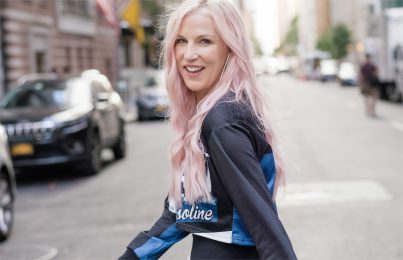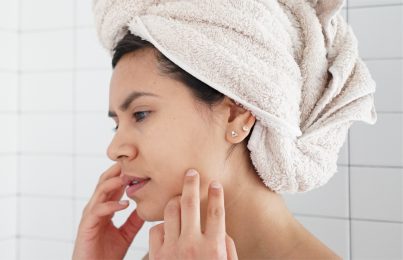Updated 05/29/24. As we learn more and more about just how harmful the sun’s rays really are, people are turning to self-tanner to get a sun-kissed glow. While I fully support the use of self-tanner as a safe alternative to sunbathing, it’s not something that I have a lot of personal experience with. I wanted to learn more about how to use self-tanner for best results, so I turned to two self-tanning experts (who just so happen to be personal friends of mine) for answers. Keep scrolling to learn what self-tanner is, how it works, and how to use it for healthy, glowing skin.
Meet the Experts
Tamra Dae is a sought-after spray tan artist who began spraying A-list clients at a Beverly Hills salon when she was just nineteen years old. In 2012, she started her own successful freelance spray tan business. People seek Tamra out for the natural tan she creates as well as her sharp attention to detail.
Kirbie Johnson is co-host of the Gloss Angeles Podcast (listen to my episode here!) as well as a fellow Texas girl and beauty junkie. Kirbie was one of the first people in the salon space to become certified as an airbrush tanner. When she moved to L.A. in 2009, she worked at Sunless Studio where she sprayed everyone from celebrities and news personalities to coworkers.
What Is Self Tanner, and Is It Safe?
Before we talk about self-tanner prep and application tips, let’s talk about what it is and whether or not it’s safe. The first thing you should know is that every single sunless tanning product on the market uses the same active ingredient to give skin a bronzed look. It’s called dihydroxyacetone, or DHA for short. It has a long and established history, having been in commercial use since 1959. It’s commonly sourced from plants such as sugar cane or sugar beets through a fermentation process, although it can also be derived chemically to create a synthetic version.
When it comes into contact with the skin, DHA reacts with the amino acids in the outermost layer of the epidermis (called the stratum corneum) to change color and mimic the look of a natural tan. Because everyone has a slightly different cocktail of amino acids in their stratum corneum, individuals react to DHA slightly differently. For example, DHA and the amino acids alanine, glutamine, and lysine will turn yellow. DHA and the amino acid asparagine will turn orange. DHA and the amino acid glycine will turn brown. The varying ratios of amino acids determine how yellow, orange or brown your self-tan will be.
The safety of DHA is well-established, and dermatologists generally consider it to be a safe alternative to UV tanning, as long as the product in question is used as directed. Tamra says that although it’s safe when applied topically, it should not be ingested, which is why it’s important to keep your mouth and eyes closed while getting a spray tan.
Can I Use Self-Tanner if I’m Pregnant?
For clients who are pregnant or breastfeeding, Tamra suggests avoiding the nipples and areolas. The American Pregnancy Association notes that some physicians encourage women to wait until after the first trimester to start using tanning products, just to be safe. If you are pregnant, patch test a self-tanning product before applying it, even if you’ve used it before, since your skin may be more sensitive during this time.
What’s the Best Self-Tanner to Use? What Should I Look For in a Formula?
Self-tanners have come a long way since they first became popular, and the formulas are much more sophisticated than they used to be. Many formulas include ingredients that are beneficial for the skin. This is a big deal to Tamra and Kirbie, who believe self-tanner should double as skincare.
Kirbie explains how she likes to use products that have CoQ10, collagen, and hyaluronic acid in them, allowing the shade ranges to look very natural on the skin. She found using latex-free gloves instead of a mitt to apply the tanning mousse leads to a more natural application and longer-lasting tan, meaning you also use less product each application.
So, what’s the takeaway? Look for products that have minimal ingredients, lightweight formulas that dry quickly, and ingredients that nourish the skin. Avoid products with harmful ingredients like drying alcohols and SLS.
How Should I Prep My Skin for Self-Tanner?
Ask any sunless tanning aficionado and they’ll tell you that skin prep is everything when it comes to achieving seamless, natural-looking color. These are the tips to keep in mind before applying self-tanner (or going in for a professional spray tan).
Plan Your Exfoliation
Exfoliation is a key part of the self-tanning prep. The goal is to remove any surface dryness that could cause your tan to look patchy or uneven once it’s developed. That said, it’s all in the timing. To start off, Kirbie recommends shaving 24 hours prior to your self-tanner application. She mentions that while you can apply self-tanner on areas with body hair, it will make the application process a little more difficult. “The hair is going to be harder to penetrate through, so you’re really going to have to rub it in,” she says.
On the day of application, Kirbie recommends sloughing off dry, dead skin cells with a mitt (Back & Body Buffing Towel also works well for this, helping with hard-to-reach areas that a generic mitt can’t access). This will give you a smooth canvas and remove any residue that might be left behind from body products. “On the day of,” she says, “I don’t recommend using any exfoliating body scrubs because they could potentially change the pH of your skin or leave a residue. In order for your tan to develop properly, your skin has to have a certain pH, and exfoliating acids will mess with this.”
The pH of your skin is important when it comes to using self-tanner. When you’re in prep mode, forget bar soap and reach for a cleanser that has a pH of around 5.5 to ensure that DHA can react properly with your skin. If the pH is too high, DHA won’t react.
Make Sure Your Skin is Dry and Clean
Kirbie also cautions against using any kind of body wash on the day you’re going to apply self-tanner. This is because many body washes can leave a residue behind. Any kind of residue can cause the tanning product to develop unevenly, resulting in patchiness. Be sure that your skin is free of perfume, lotions, and oils, too. It’s even a good idea to avoid moisturizer within 24 hours of application, although Tamra adds that if you have severely dry patches, you can apply a small amount of oil-free lotion.
Wear Loose-Fitting Clothes
Once your skin has been exfoliated, and it’s now dry and clean, make sure you have loose-fitting clothes or a robe to put on after application. This will prevent any of the self-tanner from rubbing off and then developing unevenly. When it comes to the actual application, dispense the product onto gloves or a mitt and work quickly with light, circular motions to blend everything thoroughly. Leave the product on as long as indicated before rinsing it off. (For more tips on applying self-tanner, check out Kirbie’s self-tanning tips video).
How to Maintain Your Tan and Make it Last
According to Tamra, taking care of your tan is as much about making sure the color fades away evenly as it is about extending the life of the tan. “Hydration is key,” Tamra says. “Keeping your skin moisturized is essential for the longevity of the tan because when the skin is dry, those top layers slough off quicker thus causing the color to fade. Stick to light, oil-free lotions or if you tend to be really dry, a cocoa butter or shea butter lotion will be your best friend.”
Which Ingredients Should I Avoid?
Avoid drying alcohols and heavy oils. Both can make your tan fade more quickly.
What if I Use Retinol or Exfoliating Acids on My Face?
“Know that if you do use retinoids or exfoliants on your face, neck, or décolletage, your tan will fade more quickly than your body,” Kirbie says. “And that’s fine — it’s not supposed to be permanent. If you really want to maintain the tan on your face, there are options. Use tanning drops in your moisturizer, buy face moisturizer with DHA in it, or use a spritz product to lightly dust your face after you finish your skincare routine. I would avoid using these every day, though, or your tan could get patchy in those areas.” For drops, Kirbie recommends Tan-Luxe, James Read, or Tanologist. For spray, she likes Glow on the Go from Infinity Sun.
What Sunscreen Should I Use With My Self-Tanner?
First and foremost, know that continuing to protect your skin from the sun is a MUST when you’re using a self-tanner, as DHA offers NO protection from the sun’s harmful rays. However, since it provides a sun-kissed glow to the skin, it gives some people a false sense of security. One study suggested that your skin is actually more susceptible to free radical damage 24 hours after applying DHA. All of this is to say that you still need to be diligent about sun protection when using self-tanner. Wear sun-protective clothing, seek shade, and apply sunscreen generously and consistently.
Tamra suggests using sunscreen without too many oils. “Sunscreen without heavy oils is what I recommend because oil can strip the color,” she says. “I love sunscreens that are moisturizing so I don’t have to apply both lotion and sunscreen.”
How Can I Remove Self-Tanner Without Damaging My Skin?
Here’s the thing about self-tan removal: DHA cannot be removed by sweating or washing alone. The only real way to remove DHA is through desquamation or the shedding of the top layer of the skin. As mentioned, DHA only reacts with this top layer, so your tan will fade as these cells shed and new ones take their place (that explains why active ingredients that encourage cellular turnover, like retinol and exfoliating acids, can fade your tan). Realistically, and with proper maintenance, a sunless tan should last about seven to ten days.
If you’re looking to remove your self-tanner, you can encourage this process of cellular turnover through exfoliation (just don’t over-exfoliate. Doing so can damage your skin). Kirbie notes that you’ll probably start to notice patchiness in certain areas, such as your neck and chest, after a week. “Once you see this, it’s smart to exfoliate daily,” she says. “Nothing hardcore, just a mitt or moisturizing body scrub that can help gradually reduce the tan without it looking super patchy.”
Tamra is a fan of this method as well. “I like the old-fashioned way,” she says. “A hot soak or shower and an exfoliating towel or glove. Don’t go too hard to irritate or break the skin.” While there are products made specifically to remove self-tanner, Tamra recommends doing your research before using one, especially if you have reactive skin, as some of the ingredients could be too harsh. On the same note, Kirbie cautions against using any unsanctioned DIY methods of self-tanner removal. “I’ve heard of people using Magic Eraser to remove tans, which contains bleach and is really bad for your skin,” she says. “It sounds like common sense, but I’ve had to say it in the past!”
There you have it. I certainly learned a lot from these lovely ladies and with summer coming, I may be trying out some of these tips for myself.
Next, read up on how to get your armpits smooth and summer-ready!
Celebrity Esthetician & Skincare Expert
As an esthetician trained in cosmetic chemistry, Renée Rouleau has spent 35 years researching skin, educating her audience, and building an award-winning line of products. Her hands-on experience as an esthetician and trusted skin care expert has created a real-world solution — products that are formulated for nine different types of skin so your face will get exactly what it needs to look and feel its best. Trusted by celebrities, editors, bloggers, and skincare obsessives around the globe, her vast real-world knowledge and constant research are why Marie Claire calls her “the most passionate skin practitioner we know.”




Comments:
Rene you are THE BEST and give such great and helpful information. I wish I could purchase everything you offer but even just your information is helpful for me. Sending you all my best! 💕
I miss not having your salon in Plano.
Posted By: Evelyn Carruth |
Have gone through the article and would like to appreciate your efforts for making tan this easy even for the beginners. Good luck.
Posted By: Beauty Freak |
I just arrived at this article through google search. This is very informative and interesting for those who are interested in this topic
Posted By: Jason Stone |
If you are using a product like James Read tan sleep mask, what order in your routine should you use it? And are there any products that you should avoid with it? Thanks!
Posted By: Rachel Schwab |
Hi there! I suggest reaching out to James Read for the best answer to this question. They will have the most accurate info on how to use it.
Posted By: Ella Stevenson |